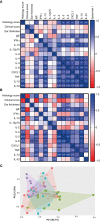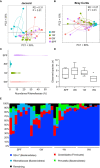Delayed Gut Colonization Shapes Future Allergic Responses in a Murine Model of Atopic Dermatitis
- PMID: 33815411
- PMCID: PMC8010263
- DOI: 10.3389/fimmu.2021.650621
Delayed Gut Colonization Shapes Future Allergic Responses in a Murine Model of Atopic Dermatitis
Abstract
Epidemiological studies have long reported that perturbations of the childhood microbiome increase the risk of developing allergies, but a causal relationship with atopic dermatitis remains unclear. Here we colonized germ-free mice at birth or at one or eight week-of-age to investigate the role of prenatal and early postnatal microbial exposure on development of oxozolone-induced dermatitis later in life. We demonstrate that only one week delayed microbial colonization increased IgE levels and the total histological score of the inflamed ear compared to mice colonized throughout life. In parallel, several pro-inflammatory cytokines and chemokines were upregulated in the ear tissue demonstrating an enhanced immunological response following delayed postnatal colonization of the gut. In contrast, sensitivity to oxazolone-induced dermatitis was unaffected by the presence of a maternal microbiota during gestation. Mice colonized at eight week-of-age failed to colonize Rikenellaceae, a group of bacteria previously associated with a high-responding phenotype, and did not develop an immunological response to the same extent as the early colonized mice despite pronounced histopathological manifestations. The study provides proof-of-principle that the first intestinal colonizers of mice pups are crucial for the development of oxazolone-induced dermatitis later in life, and that the status of the maternal microbiota during pregnancy has no influence on the offspring's allergic immune response. This highlights an important window of opportunity following birth for microbiota-mediated interventions to prevent atopic responses later in life. How long such a window is open may vary between mice and humans considering species differences in the ontogeny of the immune system.
Keywords: allergy; atopic dermatitis; childhood ezcema; early priming; gut microbiota; immune maturation; rikenellaceae; window of opportunity.
Copyright © 2021 Arildsen, Zachariassen, Krych, Hansen and Hansen.
Conflict of interest statement
The authors declare that the research was conducted in the absence of any commercial or financial relationships that could be construed as a potential conflict of interest.
Figures




Similar articles
-
Dietary prebiotics promote intestinal Prevotella in association with a low-responding phenotype in a murine oxazolone-induced model of atopic dermatitis.Sci Rep. 2020 Dec 3;10(1):21204. doi: 10.1038/s41598-020-78404-0. Sci Rep. 2020. PMID: 33273678 Free PMC article.
-
Cesarean section induced dysbiosis promotes type 2 immunity but not oxazolone-induced dermatitis in mice.Gut Microbes. 2023 Dec;15(2):2271151. doi: 10.1080/19490976.2023.2271151. Epub 2023 Oct 27. Gut Microbes. 2023. PMID: 37889696 Free PMC article.
-
A Combined Analysis of Gut and Skin Microbiota in Infants with Food Allergy and Atopic Dermatitis: A Pilot Study.Nutrients. 2021 May 15;13(5):1682. doi: 10.3390/nu13051682. Nutrients. 2021. PMID: 34063398 Free PMC article.
-
The mother-offspring dyad: microbial transmission, immune interactions and allergy development.J Intern Med. 2017 Dec;282(6):484-495. doi: 10.1111/joim.12652. Epub 2017 Aug 14. J Intern Med. 2017. PMID: 28727206 Review.
-
Demystifying Dysbiosis: Can the Gut Microbiome Promote Oral Tolerance Over IgE-mediated Food Allergy?Curr Pediatr Rev. 2018;14(3):156-163. doi: 10.2174/1573396314666180507120424. Curr Pediatr Rev. 2018. PMID: 29732975 Review.
Cited by
-
Fecal microbiota transplantation for the treatment of chronic inflammatory skin diseases.Heliyon. 2024 Sep 7;10(18):e37432. doi: 10.1016/j.heliyon.2024.e37432. eCollection 2024 Sep 30. Heliyon. 2024. PMID: 39309854 Free PMC article. Review.
-
Genetic background and microbiome drive susceptibility to epicutaneous sensitization and food allergy in adjuvant-free mouse model.Front Immunol. 2025 Jan 29;15:1509691. doi: 10.3389/fimmu.2024.1509691. eCollection 2024. Front Immunol. 2025. PMID: 39944558 Free PMC article.
-
Understanding the influence of the microbiome on childhood infections.Expert Rev Anti Infect Ther. 2024 Jul;22(7):529-545. doi: 10.1080/14787210.2024.2340664. Epub 2024 Apr 12. Expert Rev Anti Infect Ther. 2024. PMID: 38605646 Free PMC article. Review.
-
Delayed Gut Colonization Changes Future Insulin Resistance and Hepatic Gene Expression but Not Adiposity in Obese Mice.J Obes. 2024 Sep 25;2024:5846674. doi: 10.1155/2024/5846674. eCollection 2024. J Obes. 2024. PMID: 39360185 Free PMC article.
-
Effect of carrot intake on glucose tolerance, microbiota, and gene expression in a type 2 diabetes mouse model.Clin Transl Sci. 2024 Dec;17(12):e70090. doi: 10.1111/cts.70090. Clin Transl Sci. 2024. PMID: 39625861 Free PMC article.
References
MeSH terms
Substances
LinkOut - more resources
Full Text Sources
Other Literature Sources
Medical

